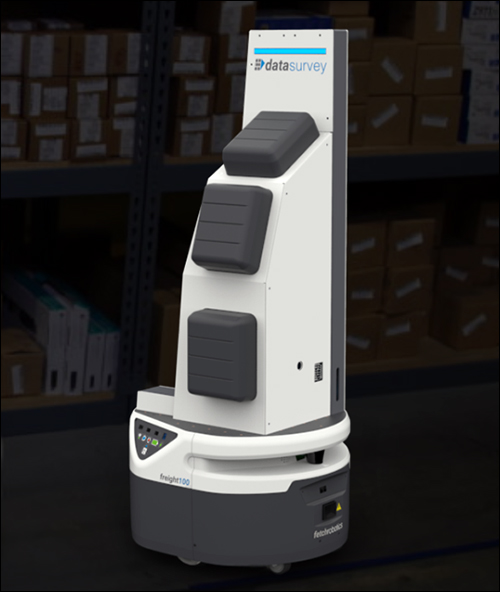May 09, 2018Several logistics companies and retailers are either piloting or deploying an RFID-enabled version of a robot that counts inventory—in some cases 24 hours a day, seven days a week—in and among personnel and moving equipment. The TagSurveyor robot, from California automation technology company Fetch Robotics, leverages UHF RFID reader technology, as well as the Freight100 robot base from sensor company Sick. The two firms demonstrated their technology at RFID Journal LIVE! 2018, held last month in Orlando, Fla.
Fetch Robotics, founded in 2014, released its first robot a year later. These autonomous machines deliver freight within warehouses and other facilities, and use sensors to navigate their routes and avoid obstacles. The company found, however, that customers could also benefit from RFID tag reading to count inventory or manage assets. Many companies, particularly those in retail and logistics, were managing items already tagged with UHF RFID tags, and didn't necessarily have the labor resources to track the locations of goods via a handheld RFID reader, or with an infrastructure of fixed readers.
The robot, then, would provide a way to read those tags without necessitating the installation of readers or requiring additional labor on the part of warehouse or retail stock-room workers. "The value is in utilizing the robot as a complement to other RFID tracking solutions," says Joe Lau, Fetch's director of product marketing. For instance, a company may have a portal to read tags as palletized goods arrive at the warehouse, but may lack an immediate way to know specifically where the goods are located once they are moved into storage.
The TagSurveyor robot comes with one internal Sick RFU630 RFID interrogator and three mounted RFA630 antennas, which send RF transmissions at three different angles, thereby ensuring that tags on products will be detected, even if they are stored on high shelves. The robot is designed for use in an active setting containing workers and vehicles, due to its multiple sensors that identify the surrounding conditions and enable it to negotiate its movements accordingly. That is unique, Lau says, since most RFID-enabled robots have been challenged when it comes to working around other robots, or in the presence of individuals or forklifts using standard obstacle-avoidance technology.
One key feature of the TagSurveyor system is how easy it is to set up, says Myles Blodnick, Fetch's application engineer. Users can unpack the robot and power it up, then begin walking it through a facility to create a map that is stored in the robot's onboard computer. That data can be forwarded to a cloud-based server via the robot's Wi-Fi functionality. In the cloud-based FetchCore software, users can view the map they have created and designate a path for the robot. They can then use the map to create "keep out" zones and alternative paths in the event that a primary path is obstructed.
Blodnick says he has witnessed users unpack the robot at 8 AM and have the mapping and visualization functionality completely up and running before lunch. However, Fetch typically works with customers for an additional day or two, Lau adds, to provide light training and optimization of workflow paths in order to ensure maximum tag read rates.
If a large facility is employing multiple TagSurveyor robots, its data can be stored on a single cloud-based server platform. Users can then dispatch the robot onto its automatic RFID read cycle. As the device moves throughout a facility, it interrogates UHF RFID tags at a distance of up to 25 feet, depending on the transmission power and tag quality, and stores that read data, along with the robot's location. "In one pass," Lau says, "an RFID [robot] can read pallets at ground level and on shelves dozens of feet off the ground."
While manual RFID tag reads can average approximately 75 to 80 percent accuracy (indicating on which shelf or in which aisle a tag is located), Fetch Robotics reports, the TagSurveyor's read accuracy is close to 100 percent. "It's been a very reliable tool," Lau says, in the deployments that have taken place at large third-party-logistics provider companies, as well as in the warehouses of several large manufacturers.
The system is available on a "no money down service agreement subscription model," Lau says, or for outright purchase. The robot's rechargeable batteries have about a nine-hour lifespan, after which they require a three-hour recharging period. The TagSurveyor uses the company's wide-angle laser scanner and 3D sensor, among other devices, to accomplish navigation. The reader can use multiple antennas to identify the direction from which tags are read.
Fetch Robotics argues that robots provide a more effective inventory-tracking system than drones—in part, because they have a longer battery life than most drones. What's more, robots can move indoors, such as in areas containing low ceilings, which drones cannot access.
Sick sells a variety of sensor technologies and RFID readers, including the UHF RFU630 built into the Fetch robots. The reader comes with two antennas built in to detect the angle of RFID tags, in a single plane, as they move down a conveyor, says Daniel Thomas, Sick's business-development manager. The RFMS system is designed for baggage tracking at airports, as well as for reading tags in the logistics and retail sectors, in which boxes or pallets loaded with products pass through a portal tunnel. The reader uses built-in algorithms to calculate the direction from which a tag responds to interrogation, as well as its movement.



